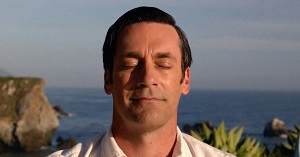What makes a landscape a Zen landscape? In a well-known episode from Mad Men, Don Draper dreams up a Coke ad while meditating by the sea. Does this scene qualify?
More than six centuries ago, painter-monks in China and Japan sought to express the spirit of Zen in landscape paintings. An early virtuoso was the Chinese monk Mu Qi (1210-1269; pronounced moo chee). Trained by a prominent Zen master, Mu Qi later headed a monastery. His work survives primarily because it was collected by the rulers of another country, Japan. Here is an example:
This scroll, 13" high and 45" long, presents a peaceful river scene. Upon closer inspection we find rooftops hidden by trees, boats low in the water, a fisherman holding a net. The river fades into mist, which in turn fades into space. Title: "A Fishing Village in the Glow of Evening."
In Mu Qi's landscape, the relationship between people and nature seems to be in balance. In the "Mad Men" image above, one person steals the show. Nature is reduced to a backdrop.
Horizontal landscape scrolls are read from right to left. River scenes allow viewers to imagine that they are floating down the river, appreciating the sights. In a digital age, we can again float down the river vicariously: enlarge the image to fill your screen, then scroll (now a verb) horizontally.
Mu Qi's painting was one of "Eight Views of the Xiao and Xiang Rivers," a theme already popular in cultured circles. The two rivers flow into a lake in Hunan province. The Eight Views were linked to a poem by a Zen monk, an example of the close relation between Zen, poetry, and painting.
The style epitomized by Mu Qi soon found its way to Japan, where it had immediate and lasting impact. About 250 years after Mu Qi, a Japanese painter unveiled this scene:
The painter, Sōami (1485?-1525; p. so-ahmee), belonged to a distinguished family; like his forebears, he advised Japan's samurai rulers on art and culture. Sōami painted this landscape on door-size panels (fusuma) for the inauguration of a Zen temple in Kyoto, circa 1513. Title: "A Fishing Village in the Glow of Evening."
The fact that Sōami had never laid eyes on the Xiao or Xiang Rivers did not pose a problem. Both cultures revered tradition, and painters learned by copying. Manuals illustrated the classic brushstrokes for everything from moths to mountains. In this milieu, Sōami's work was seen as an homage to Mu Qi.
Here is a closer look at one of Sōami's panels (third from the right):
Zen painters liked the simplicity and versatility of black ink. It was all about the ink -- the amount taken up by the brush, the length of time a brush full was used before re-inking, the paleness of the washes, the blackness of the dots. For artist-monks, the way of the brush and the way of meditation had much in common. Both affirm the oneness of self and other, landscape and mindscape. "Bury the brush again and again in the ink and grind the inkstone to dust," one manual urged, sounding like a Zen master bearing down on his monks.
The two landscapes are remarkably congruent, by any measure. Across a span of 250 years and two cultures, Sōami not only recreates Mu Qi's panorama, he achieves comparable depth and beauty. The paintings highlight the closeness of Chinese Zen and Japanese Zen. Does this closeness also lend support to claims of spiritual continuity? Zen calls itself a transmission of Mind, a lineage of awakening. If that is the real thing, Coke doesn't stand a chance.
Photo credits: 1) AMC; 2) Nezu Museum, Tokyo; 3) Daisen-in, Kyoto; 4) detail.



